HRM Challenges: Attracting and Retaining Staff in Hospitality Industry
VerifiedAdded on 2023/06/04
|10
|3352
|188
Essay
AI Summary
This essay examines the critical challenges in attracting and retaining staff within the rapidly growing and highly competitive hospitality industry. It highlights the importance of skilled employees in delivering superior customer service and explores various factors influencing employee retention, such as organizational cost, job satisfaction, and motivation. The essay also discusses the role of HR planning and management practices in creating a positive work environment that attracts new talent. Key issues like lack of motivation, inadequate management support, and the need for employee development are addressed, emphasizing the significance of strategic HRM in fostering a committed and productive workforce within the hospitality sector. The essay also touches upon the evaluation methods to ensure employee satisfaction.
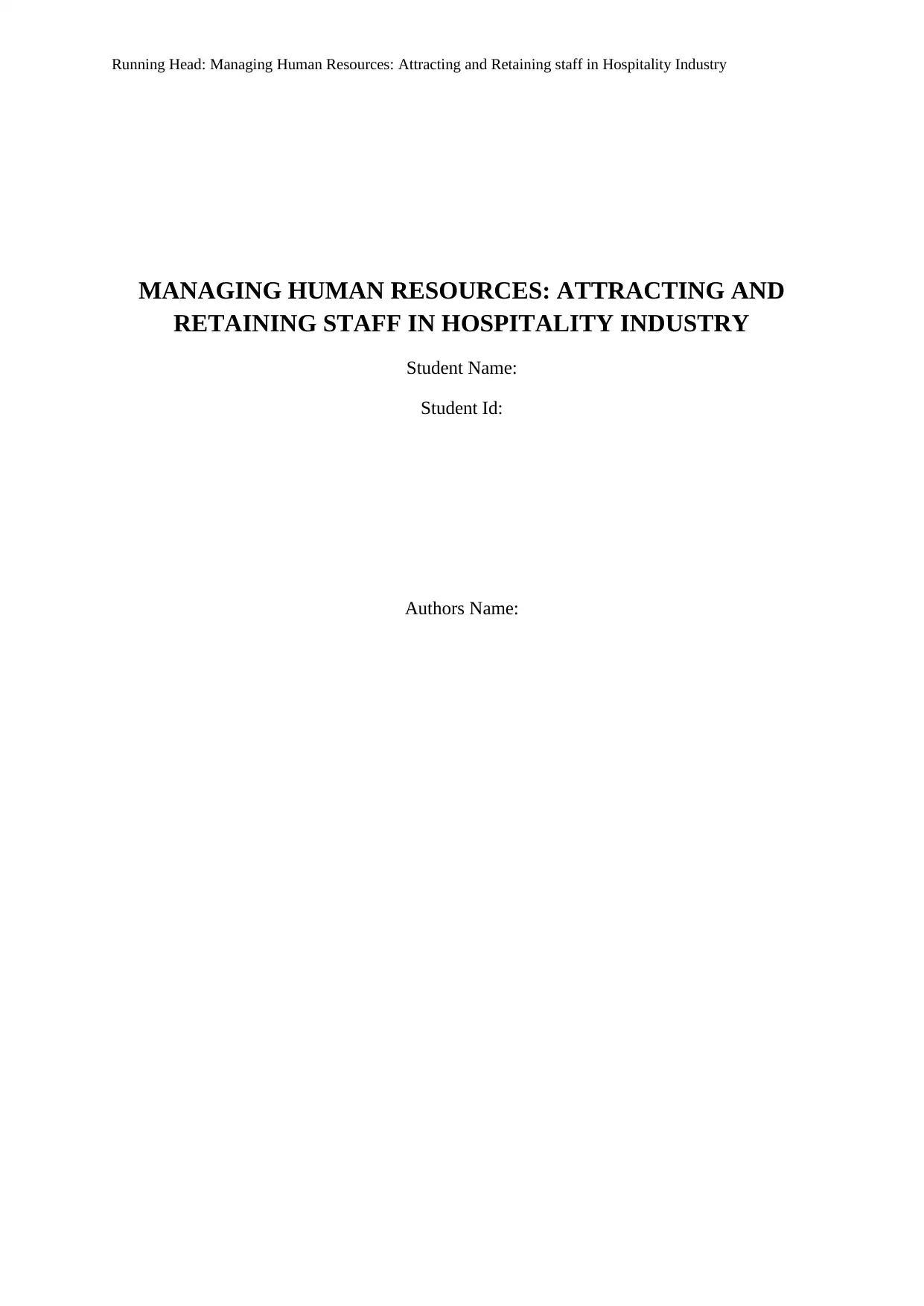
Running Head: Managing Human Resources: Attracting and Retaining staff in Hospitality Industry
MANAGING HUMAN RESOURCES: ATTRACTING AND
RETAINING STAFF IN HOSPITALITY INDUSTRY
Student Name:
Student Id:
Authors Name:
MANAGING HUMAN RESOURCES: ATTRACTING AND
RETAINING STAFF IN HOSPITALITY INDUSTRY
Student Name:
Student Id:
Authors Name:
Paraphrase This Document
Need a fresh take? Get an instant paraphrase of this document with our AI Paraphraser
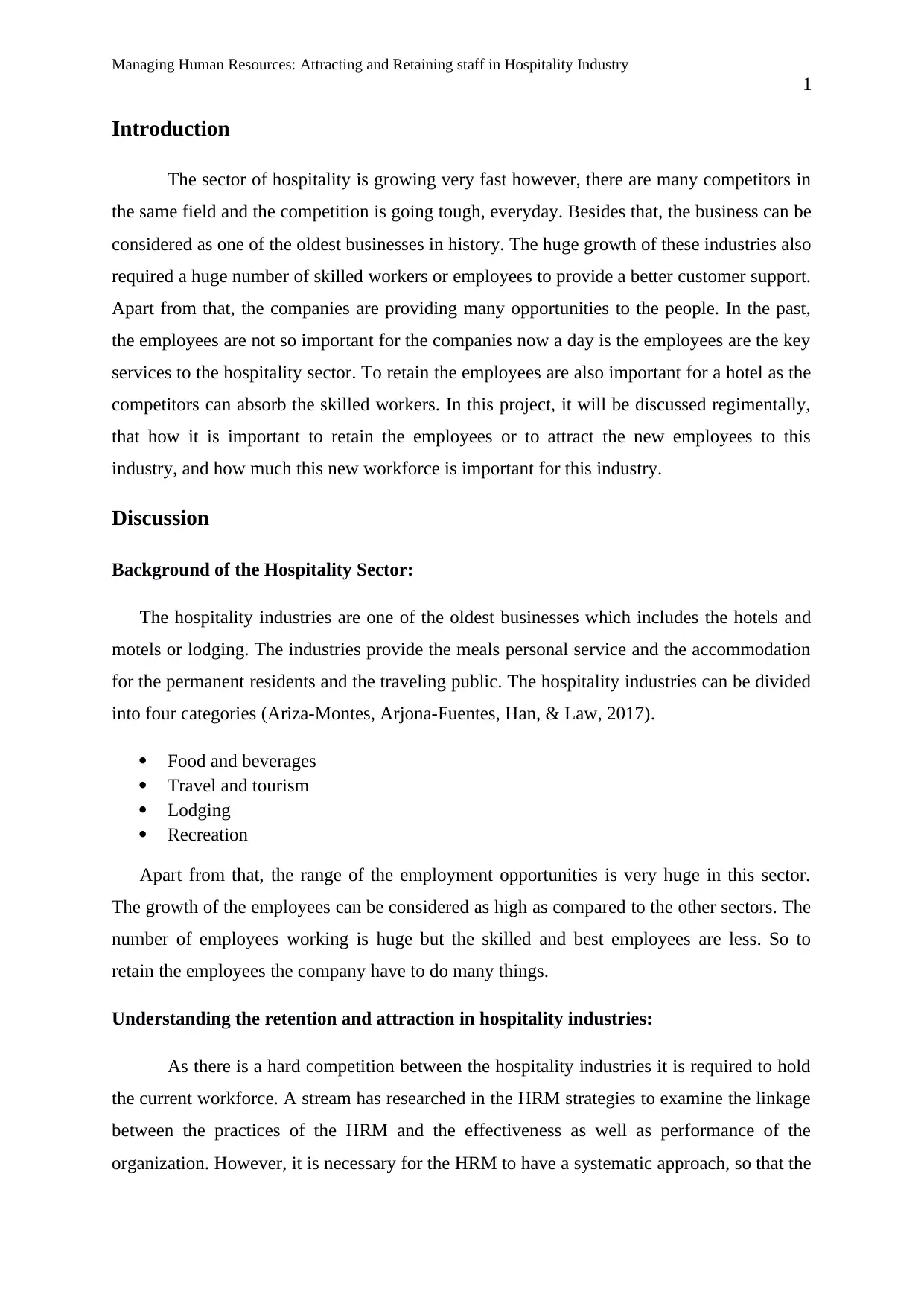
Managing Human Resources: Attracting and Retaining staff in Hospitality Industry
1
Introduction
The sector of hospitality is growing very fast however, there are many competitors in
the same field and the competition is going tough, everyday. Besides that, the business can be
considered as one of the oldest businesses in history. The huge growth of these industries also
required a huge number of skilled workers or employees to provide a better customer support.
Apart from that, the companies are providing many opportunities to the people. In the past,
the employees are not so important for the companies now a day is the employees are the key
services to the hospitality sector. To retain the employees are also important for a hotel as the
competitors can absorb the skilled workers. In this project, it will be discussed regimentally,
that how it is important to retain the employees or to attract the new employees to this
industry, and how much this new workforce is important for this industry.
Discussion
Background of the Hospitality Sector:
The hospitality industries are one of the oldest businesses which includes the hotels and
motels or lodging. The industries provide the meals personal service and the accommodation
for the permanent residents and the traveling public. The hospitality industries can be divided
into four categories (Ariza-Montes, Arjona-Fuentes, Han, & Law, 2017).
Food and beverages
Travel and tourism
Lodging
Recreation
Apart from that, the range of the employment opportunities is very huge in this sector.
The growth of the employees can be considered as high as compared to the other sectors. The
number of employees working is huge but the skilled and best employees are less. So to
retain the employees the company have to do many things.
Understanding the retention and attraction in hospitality industries:
As there is a hard competition between the hospitality industries it is required to hold
the current workforce. A stream has researched in the HRM strategies to examine the linkage
between the practices of the HRM and the effectiveness as well as performance of the
organization. However, it is necessary for the HRM to have a systematic approach, so that the
1
Introduction
The sector of hospitality is growing very fast however, there are many competitors in
the same field and the competition is going tough, everyday. Besides that, the business can be
considered as one of the oldest businesses in history. The huge growth of these industries also
required a huge number of skilled workers or employees to provide a better customer support.
Apart from that, the companies are providing many opportunities to the people. In the past,
the employees are not so important for the companies now a day is the employees are the key
services to the hospitality sector. To retain the employees are also important for a hotel as the
competitors can absorb the skilled workers. In this project, it will be discussed regimentally,
that how it is important to retain the employees or to attract the new employees to this
industry, and how much this new workforce is important for this industry.
Discussion
Background of the Hospitality Sector:
The hospitality industries are one of the oldest businesses which includes the hotels and
motels or lodging. The industries provide the meals personal service and the accommodation
for the permanent residents and the traveling public. The hospitality industries can be divided
into four categories (Ariza-Montes, Arjona-Fuentes, Han, & Law, 2017).
Food and beverages
Travel and tourism
Lodging
Recreation
Apart from that, the range of the employment opportunities is very huge in this sector.
The growth of the employees can be considered as high as compared to the other sectors. The
number of employees working is huge but the skilled and best employees are less. So to
retain the employees the company have to do many things.
Understanding the retention and attraction in hospitality industries:
As there is a hard competition between the hospitality industries it is required to hold
the current workforce. A stream has researched in the HRM strategies to examine the linkage
between the practices of the HRM and the effectiveness as well as performance of the
organization. However, it is necessary for the HRM to have a systematic approach, so that the
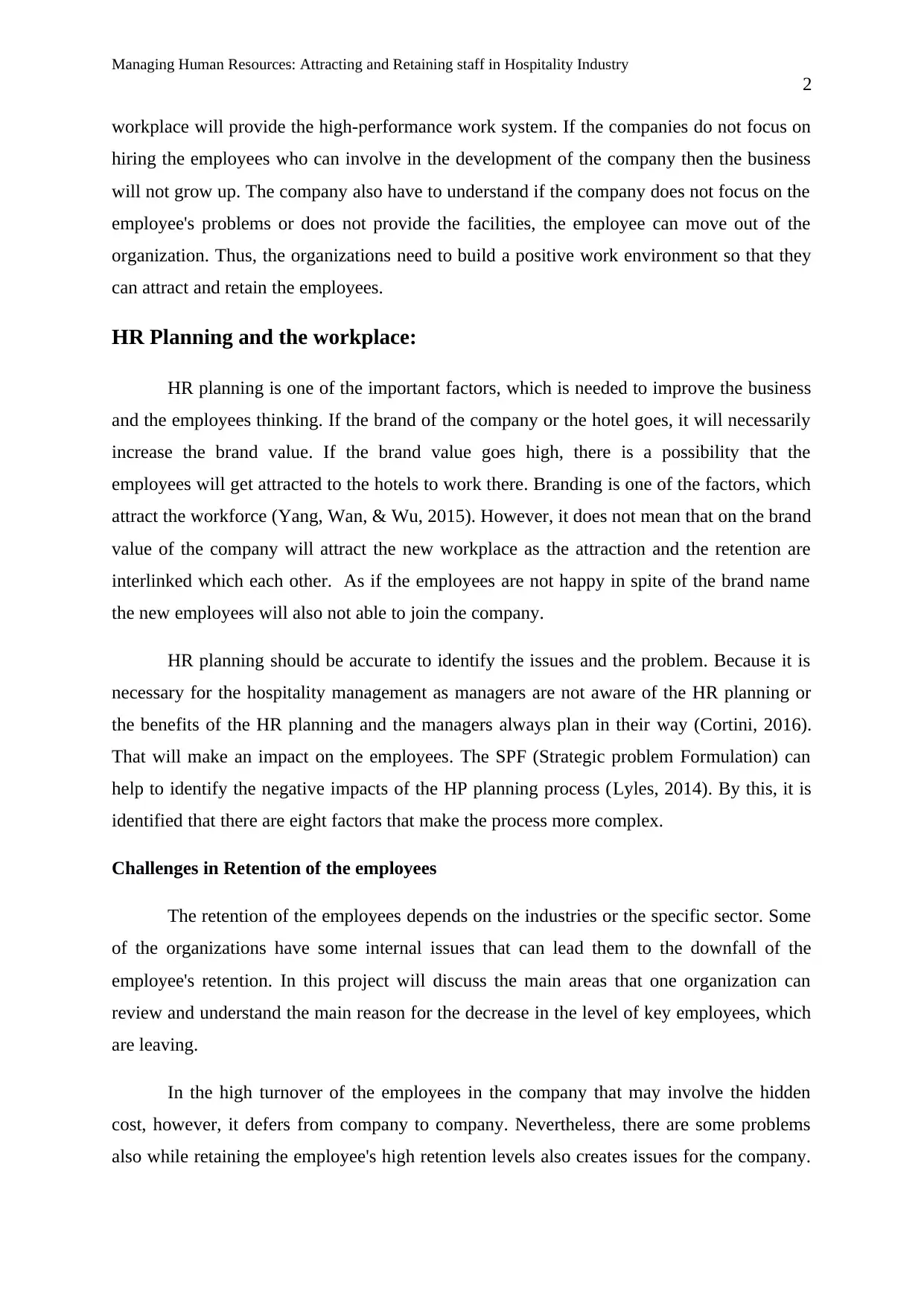
Managing Human Resources: Attracting and Retaining staff in Hospitality Industry
2
workplace will provide the high-performance work system. If the companies do not focus on
hiring the employees who can involve in the development of the company then the business
will not grow up. The company also have to understand if the company does not focus on the
employee's problems or does not provide the facilities, the employee can move out of the
organization. Thus, the organizations need to build a positive work environment so that they
can attract and retain the employees.
HR Planning and the workplace:
HR planning is one of the important factors, which is needed to improve the business
and the employees thinking. If the brand of the company or the hotel goes, it will necessarily
increase the brand value. If the brand value goes high, there is a possibility that the
employees will get attracted to the hotels to work there. Branding is one of the factors, which
attract the workforce (Yang, Wan, & Wu, 2015). However, it does not mean that on the brand
value of the company will attract the new workplace as the attraction and the retention are
interlinked which each other. As if the employees are not happy in spite of the brand name
the new employees will also not able to join the company.
HR planning should be accurate to identify the issues and the problem. Because it is
necessary for the hospitality management as managers are not aware of the HR planning or
the benefits of the HR planning and the managers always plan in their way (Cortini, 2016).
That will make an impact on the employees. The SPF (Strategic problem Formulation) can
help to identify the negative impacts of the HP planning process (Lyles, 2014). By this, it is
identified that there are eight factors that make the process more complex.
Challenges in Retention of the employees
The retention of the employees depends on the industries or the specific sector. Some
of the organizations have some internal issues that can lead them to the downfall of the
employee's retention. In this project will discuss the main areas that one organization can
review and understand the main reason for the decrease in the level of key employees, which
are leaving.
In the high turnover of the employees in the company that may involve the hidden
cost, however, it defers from company to company. Nevertheless, there are some problems
also while retaining the employee's high retention levels also creates issues for the company.
2
workplace will provide the high-performance work system. If the companies do not focus on
hiring the employees who can involve in the development of the company then the business
will not grow up. The company also have to understand if the company does not focus on the
employee's problems or does not provide the facilities, the employee can move out of the
organization. Thus, the organizations need to build a positive work environment so that they
can attract and retain the employees.
HR Planning and the workplace:
HR planning is one of the important factors, which is needed to improve the business
and the employees thinking. If the brand of the company or the hotel goes, it will necessarily
increase the brand value. If the brand value goes high, there is a possibility that the
employees will get attracted to the hotels to work there. Branding is one of the factors, which
attract the workforce (Yang, Wan, & Wu, 2015). However, it does not mean that on the brand
value of the company will attract the new workplace as the attraction and the retention are
interlinked which each other. As if the employees are not happy in spite of the brand name
the new employees will also not able to join the company.
HR planning should be accurate to identify the issues and the problem. Because it is
necessary for the hospitality management as managers are not aware of the HR planning or
the benefits of the HR planning and the managers always plan in their way (Cortini, 2016).
That will make an impact on the employees. The SPF (Strategic problem Formulation) can
help to identify the negative impacts of the HP planning process (Lyles, 2014). By this, it is
identified that there are eight factors that make the process more complex.
Challenges in Retention of the employees
The retention of the employees depends on the industries or the specific sector. Some
of the organizations have some internal issues that can lead them to the downfall of the
employee's retention. In this project will discuss the main areas that one organization can
review and understand the main reason for the decrease in the level of key employees, which
are leaving.
In the high turnover of the employees in the company that may involve the hidden
cost, however, it defers from company to company. Nevertheless, there are some problems
also while retaining the employee's high retention levels also creates issues for the company.
⊘ This is a preview!⊘
Do you want full access?
Subscribe today to unlock all pages.

Trusted by 1+ million students worldwide
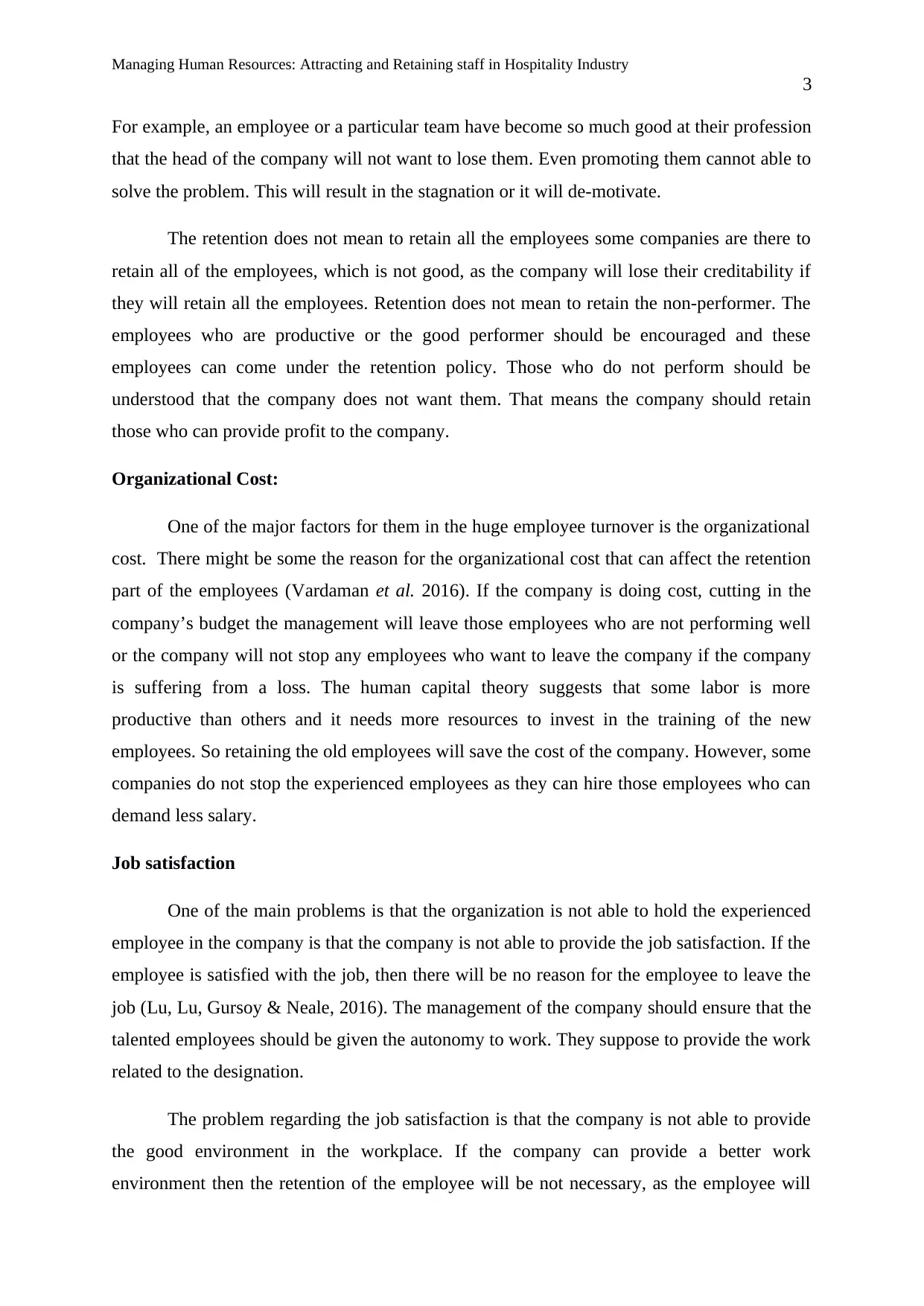
Managing Human Resources: Attracting and Retaining staff in Hospitality Industry
3
For example, an employee or a particular team have become so much good at their profession
that the head of the company will not want to lose them. Even promoting them cannot able to
solve the problem. This will result in the stagnation or it will de-motivate.
The retention does not mean to retain all the employees some companies are there to
retain all of the employees, which is not good, as the company will lose their creditability if
they will retain all the employees. Retention does not mean to retain the non-performer. The
employees who are productive or the good performer should be encouraged and these
employees can come under the retention policy. Those who do not perform should be
understood that the company does not want them. That means the company should retain
those who can provide profit to the company.
Organizational Cost:
One of the major factors for them in the huge employee turnover is the organizational
cost. There might be some the reason for the organizational cost that can affect the retention
part of the employees (Vardaman et al. 2016). If the company is doing cost, cutting in the
company’s budget the management will leave those employees who are not performing well
or the company will not stop any employees who want to leave the company if the company
is suffering from a loss. The human capital theory suggests that some labor is more
productive than others and it needs more resources to invest in the training of the new
employees. So retaining the old employees will save the cost of the company. However, some
companies do not stop the experienced employees as they can hire those employees who can
demand less salary.
Job satisfaction
One of the main problems is that the organization is not able to hold the experienced
employee in the company is that the company is not able to provide the job satisfaction. If the
employee is satisfied with the job, then there will be no reason for the employee to leave the
job (Lu, Lu, Gursoy & Neale, 2016). The management of the company should ensure that the
talented employees should be given the autonomy to work. They suppose to provide the work
related to the designation.
The problem regarding the job satisfaction is that the company is not able to provide
the good environment in the workplace. If the company can provide a better work
environment then the retention of the employee will be not necessary, as the employee will
3
For example, an employee or a particular team have become so much good at their profession
that the head of the company will not want to lose them. Even promoting them cannot able to
solve the problem. This will result in the stagnation or it will de-motivate.
The retention does not mean to retain all the employees some companies are there to
retain all of the employees, which is not good, as the company will lose their creditability if
they will retain all the employees. Retention does not mean to retain the non-performer. The
employees who are productive or the good performer should be encouraged and these
employees can come under the retention policy. Those who do not perform should be
understood that the company does not want them. That means the company should retain
those who can provide profit to the company.
Organizational Cost:
One of the major factors for them in the huge employee turnover is the organizational
cost. There might be some the reason for the organizational cost that can affect the retention
part of the employees (Vardaman et al. 2016). If the company is doing cost, cutting in the
company’s budget the management will leave those employees who are not performing well
or the company will not stop any employees who want to leave the company if the company
is suffering from a loss. The human capital theory suggests that some labor is more
productive than others and it needs more resources to invest in the training of the new
employees. So retaining the old employees will save the cost of the company. However, some
companies do not stop the experienced employees as they can hire those employees who can
demand less salary.
Job satisfaction
One of the main problems is that the organization is not able to hold the experienced
employee in the company is that the company is not able to provide the job satisfaction. If the
employee is satisfied with the job, then there will be no reason for the employee to leave the
job (Lu, Lu, Gursoy & Neale, 2016). The management of the company should ensure that the
talented employees should be given the autonomy to work. They suppose to provide the work
related to the designation.
The problem regarding the job satisfaction is that the company is not able to provide
the good environment in the workplace. If the company can provide a better work
environment then the retention of the employee will be not necessary, as the employee will
Paraphrase This Document
Need a fresh take? Get an instant paraphrase of this document with our AI Paraphraser
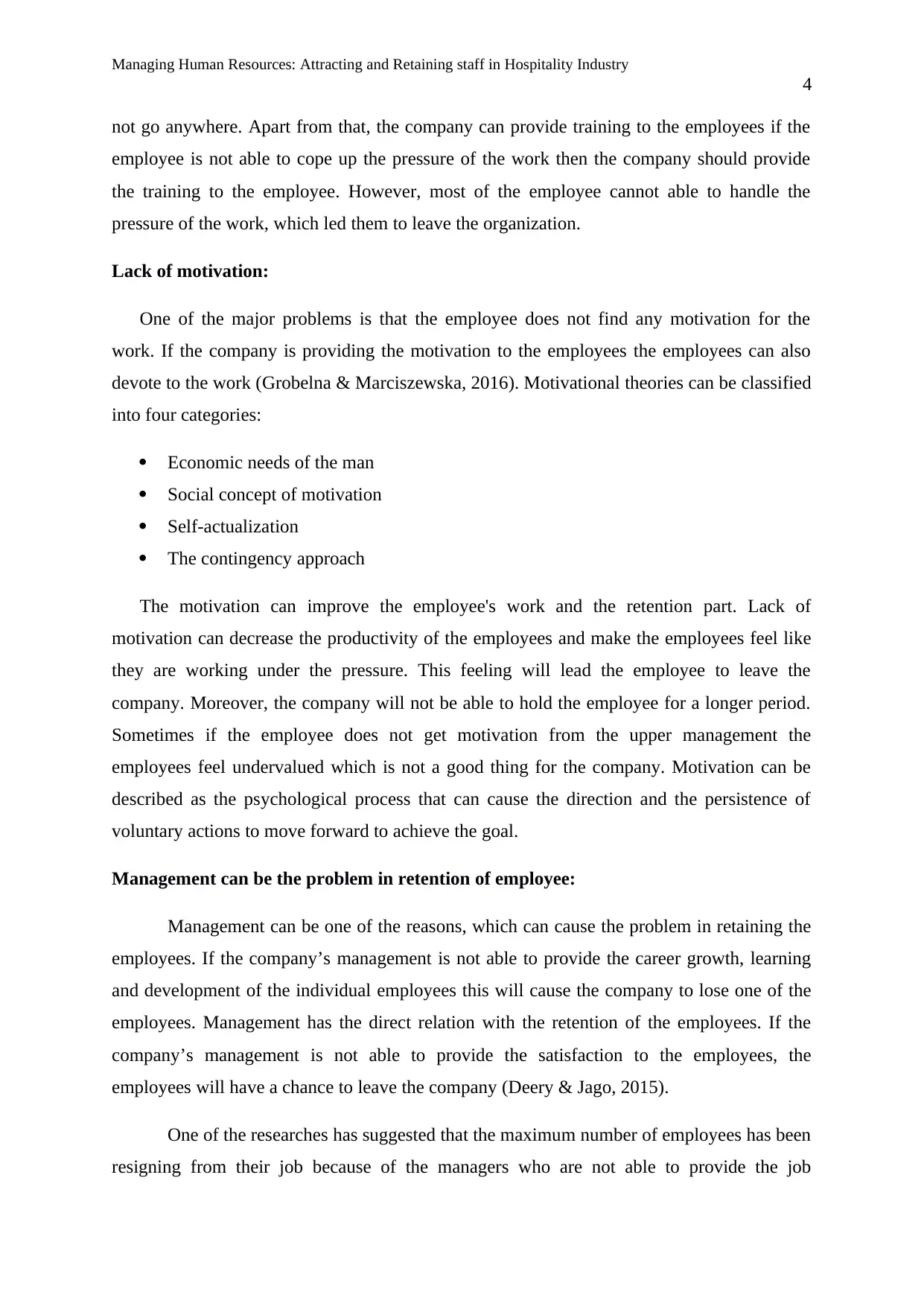
Managing Human Resources: Attracting and Retaining staff in Hospitality Industry
4
not go anywhere. Apart from that, the company can provide training to the employees if the
employee is not able to cope up the pressure of the work then the company should provide
the training to the employee. However, most of the employee cannot able to handle the
pressure of the work, which led them to leave the organization.
Lack of motivation:
One of the major problems is that the employee does not find any motivation for the
work. If the company is providing the motivation to the employees the employees can also
devote to the work (Grobelna & Marciszewska, 2016). Motivational theories can be classified
into four categories:
Economic needs of the man
Social concept of motivation
Self-actualization
The contingency approach
The motivation can improve the employee's work and the retention part. Lack of
motivation can decrease the productivity of the employees and make the employees feel like
they are working under the pressure. This feeling will lead the employee to leave the
company. Moreover, the company will not be able to hold the employee for a longer period.
Sometimes if the employee does not get motivation from the upper management the
employees feel undervalued which is not a good thing for the company. Motivation can be
described as the psychological process that can cause the direction and the persistence of
voluntary actions to move forward to achieve the goal.
Management can be the problem in retention of employee:
Management can be one of the reasons, which can cause the problem in retaining the
employees. If the company’s management is not able to provide the career growth, learning
and development of the individual employees this will cause the company to lose one of the
employees. Management has the direct relation with the retention of the employees. If the
company’s management is not able to provide the satisfaction to the employees, the
employees will have a chance to leave the company (Deery & Jago, 2015).
One of the researches has suggested that the maximum number of employees has been
resigning from their job because of the managers who are not able to provide the job
4
not go anywhere. Apart from that, the company can provide training to the employees if the
employee is not able to cope up the pressure of the work then the company should provide
the training to the employee. However, most of the employee cannot able to handle the
pressure of the work, which led them to leave the organization.
Lack of motivation:
One of the major problems is that the employee does not find any motivation for the
work. If the company is providing the motivation to the employees the employees can also
devote to the work (Grobelna & Marciszewska, 2016). Motivational theories can be classified
into four categories:
Economic needs of the man
Social concept of motivation
Self-actualization
The contingency approach
The motivation can improve the employee's work and the retention part. Lack of
motivation can decrease the productivity of the employees and make the employees feel like
they are working under the pressure. This feeling will lead the employee to leave the
company. Moreover, the company will not be able to hold the employee for a longer period.
Sometimes if the employee does not get motivation from the upper management the
employees feel undervalued which is not a good thing for the company. Motivation can be
described as the psychological process that can cause the direction and the persistence of
voluntary actions to move forward to achieve the goal.
Management can be the problem in retention of employee:
Management can be one of the reasons, which can cause the problem in retaining the
employees. If the company’s management is not able to provide the career growth, learning
and development of the individual employees this will cause the company to lose one of the
employees. Management has the direct relation with the retention of the employees. If the
company’s management is not able to provide the satisfaction to the employees, the
employees will have a chance to leave the company (Deery & Jago, 2015).
One of the researches has suggested that the maximum number of employees has been
resigning from their job because of the managers who are not able to provide the job
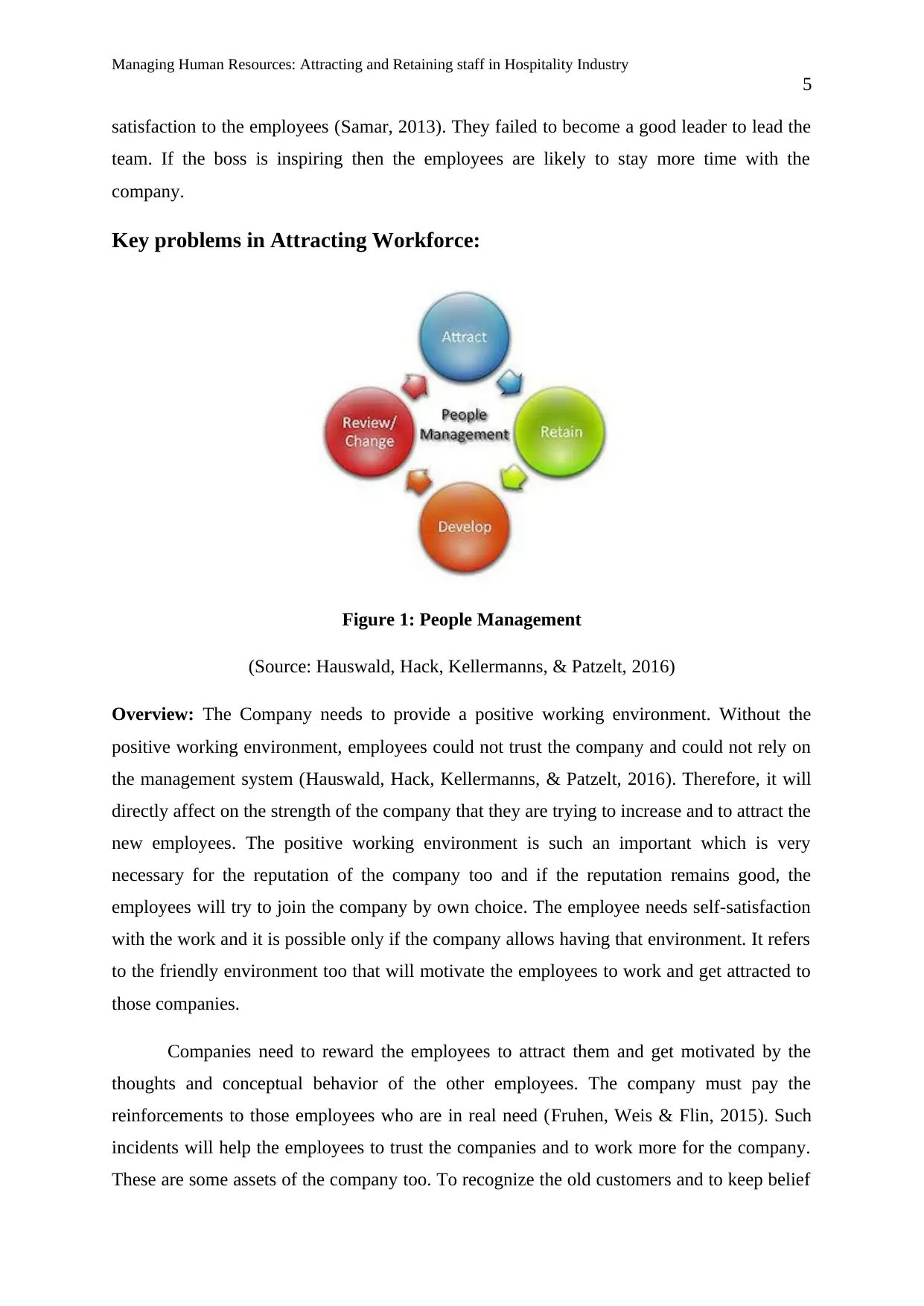
Managing Human Resources: Attracting and Retaining staff in Hospitality Industry
5
satisfaction to the employees (Samar, 2013). They failed to become a good leader to lead the
team. If the boss is inspiring then the employees are likely to stay more time with the
company.
Key problems in Attracting Workforce:
Figure 1: People Management
(Source: Hauswald, Hack, Kellermanns, & Patzelt, 2016)
Overview: The Company needs to provide a positive working environment. Without the
positive working environment, employees could not trust the company and could not rely on
the management system (Hauswald, Hack, Kellermanns, & Patzelt, 2016). Therefore, it will
directly affect on the strength of the company that they are trying to increase and to attract the
new employees. The positive working environment is such an important which is very
necessary for the reputation of the company too and if the reputation remains good, the
employees will try to join the company by own choice. The employee needs self-satisfaction
with the work and it is possible only if the company allows having that environment. It refers
to the friendly environment too that will motivate the employees to work and get attracted to
those companies.
Companies need to reward the employees to attract them and get motivated by the
thoughts and conceptual behavior of the other employees. The company must pay the
reinforcements to those employees who are in real need (Fruhen, Weis & Flin, 2015). Such
incidents will help the employees to trust the companies and to work more for the company.
These are some assets of the company too. To recognize the old customers and to keep belief
5
satisfaction to the employees (Samar, 2013). They failed to become a good leader to lead the
team. If the boss is inspiring then the employees are likely to stay more time with the
company.
Key problems in Attracting Workforce:
Figure 1: People Management
(Source: Hauswald, Hack, Kellermanns, & Patzelt, 2016)
Overview: The Company needs to provide a positive working environment. Without the
positive working environment, employees could not trust the company and could not rely on
the management system (Hauswald, Hack, Kellermanns, & Patzelt, 2016). Therefore, it will
directly affect on the strength of the company that they are trying to increase and to attract the
new employees. The positive working environment is such an important which is very
necessary for the reputation of the company too and if the reputation remains good, the
employees will try to join the company by own choice. The employee needs self-satisfaction
with the work and it is possible only if the company allows having that environment. It refers
to the friendly environment too that will motivate the employees to work and get attracted to
those companies.
Companies need to reward the employees to attract them and get motivated by the
thoughts and conceptual behavior of the other employees. The company must pay the
reinforcements to those employees who are in real need (Fruhen, Weis & Flin, 2015). Such
incidents will help the employees to trust the companies and to work more for the company.
These are some assets of the company too. To recognize the old customers and to keep belief
⊘ This is a preview!⊘
Do you want full access?
Subscribe today to unlock all pages.

Trusted by 1+ million students worldwide
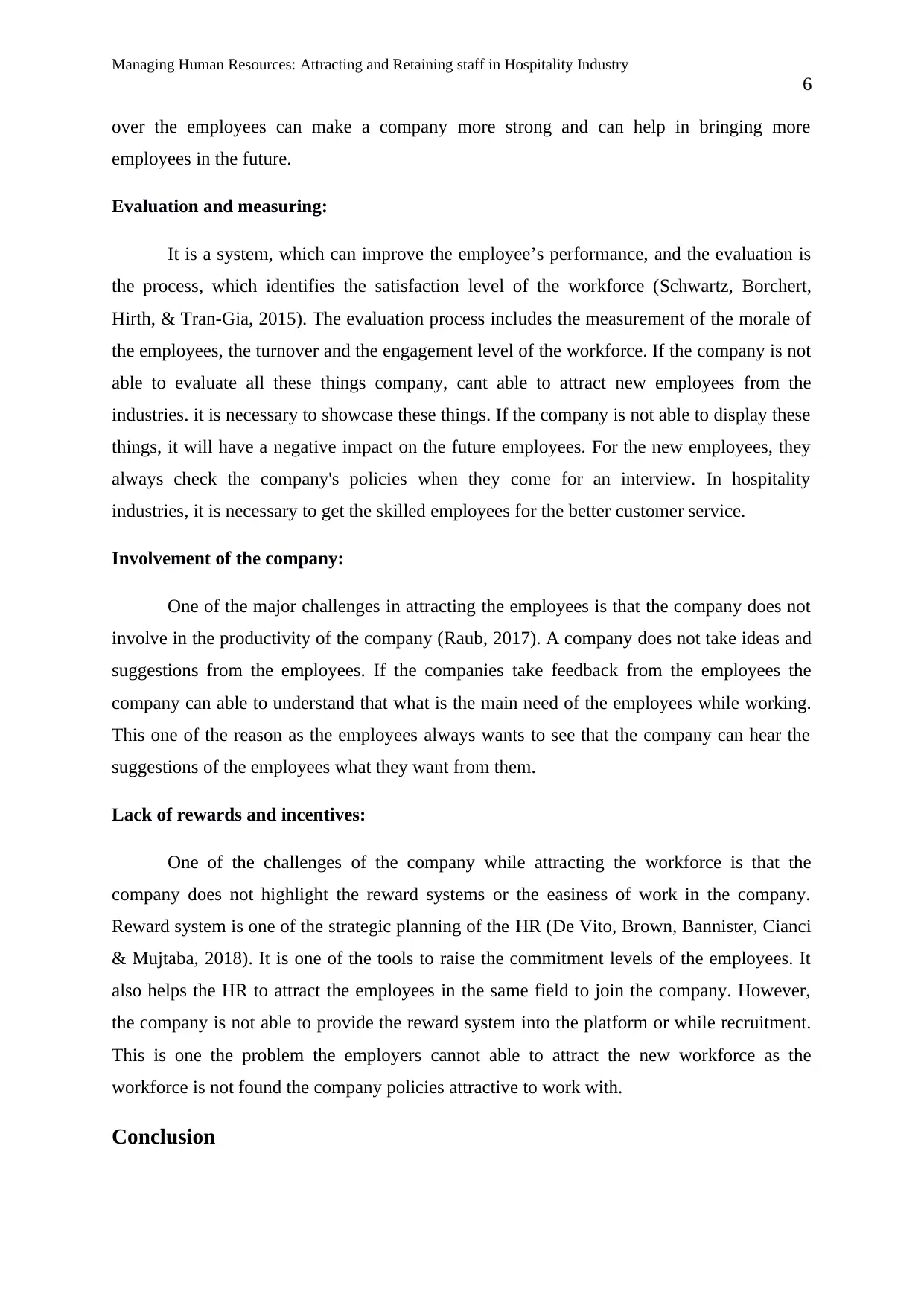
Managing Human Resources: Attracting and Retaining staff in Hospitality Industry
6
over the employees can make a company more strong and can help in bringing more
employees in the future.
Evaluation and measuring:
It is a system, which can improve the employee’s performance, and the evaluation is
the process, which identifies the satisfaction level of the workforce (Schwartz, Borchert,
Hirth, & Tran-Gia, 2015). The evaluation process includes the measurement of the morale of
the employees, the turnover and the engagement level of the workforce. If the company is not
able to evaluate all these things company, cant able to attract new employees from the
industries. it is necessary to showcase these things. If the company is not able to display these
things, it will have a negative impact on the future employees. For the new employees, they
always check the company's policies when they come for an interview. In hospitality
industries, it is necessary to get the skilled employees for the better customer service.
Involvement of the company:
One of the major challenges in attracting the employees is that the company does not
involve in the productivity of the company (Raub, 2017). A company does not take ideas and
suggestions from the employees. If the companies take feedback from the employees the
company can able to understand that what is the main need of the employees while working.
This one of the reason as the employees always wants to see that the company can hear the
suggestions of the employees what they want from them.
Lack of rewards and incentives:
One of the challenges of the company while attracting the workforce is that the
company does not highlight the reward systems or the easiness of work in the company.
Reward system is one of the strategic planning of the HR (De Vito, Brown, Bannister, Cianci
& Mujtaba, 2018). It is one of the tools to raise the commitment levels of the employees. It
also helps the HR to attract the employees in the same field to join the company. However,
the company is not able to provide the reward system into the platform or while recruitment.
This is one the problem the employers cannot able to attract the new workforce as the
workforce is not found the company policies attractive to work with.
Conclusion
6
over the employees can make a company more strong and can help in bringing more
employees in the future.
Evaluation and measuring:
It is a system, which can improve the employee’s performance, and the evaluation is
the process, which identifies the satisfaction level of the workforce (Schwartz, Borchert,
Hirth, & Tran-Gia, 2015). The evaluation process includes the measurement of the morale of
the employees, the turnover and the engagement level of the workforce. If the company is not
able to evaluate all these things company, cant able to attract new employees from the
industries. it is necessary to showcase these things. If the company is not able to display these
things, it will have a negative impact on the future employees. For the new employees, they
always check the company's policies when they come for an interview. In hospitality
industries, it is necessary to get the skilled employees for the better customer service.
Involvement of the company:
One of the major challenges in attracting the employees is that the company does not
involve in the productivity of the company (Raub, 2017). A company does not take ideas and
suggestions from the employees. If the companies take feedback from the employees the
company can able to understand that what is the main need of the employees while working.
This one of the reason as the employees always wants to see that the company can hear the
suggestions of the employees what they want from them.
Lack of rewards and incentives:
One of the challenges of the company while attracting the workforce is that the
company does not highlight the reward systems or the easiness of work in the company.
Reward system is one of the strategic planning of the HR (De Vito, Brown, Bannister, Cianci
& Mujtaba, 2018). It is one of the tools to raise the commitment levels of the employees. It
also helps the HR to attract the employees in the same field to join the company. However,
the company is not able to provide the reward system into the platform or while recruitment.
This is one the problem the employers cannot able to attract the new workforce as the
workforce is not found the company policies attractive to work with.
Conclusion
Paraphrase This Document
Need a fresh take? Get an instant paraphrase of this document with our AI Paraphraser
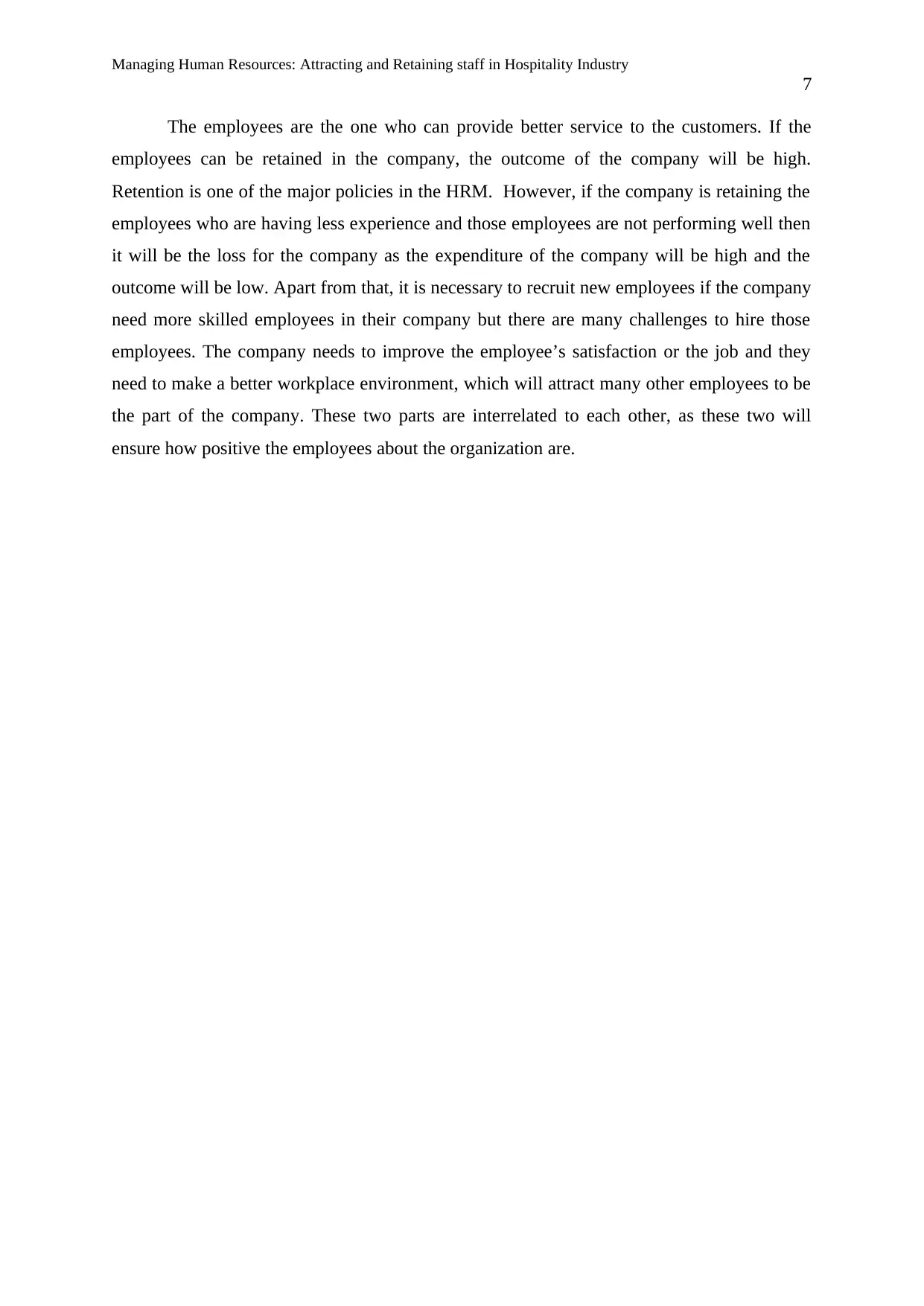
Managing Human Resources: Attracting and Retaining staff in Hospitality Industry
7
The employees are the one who can provide better service to the customers. If the
employees can be retained in the company, the outcome of the company will be high.
Retention is one of the major policies in the HRM. However, if the company is retaining the
employees who are having less experience and those employees are not performing well then
it will be the loss for the company as the expenditure of the company will be high and the
outcome will be low. Apart from that, it is necessary to recruit new employees if the company
need more skilled employees in their company but there are many challenges to hire those
employees. The company needs to improve the employee’s satisfaction or the job and they
need to make a better workplace environment, which will attract many other employees to be
the part of the company. These two parts are interrelated to each other, as these two will
ensure how positive the employees about the organization are.
7
The employees are the one who can provide better service to the customers. If the
employees can be retained in the company, the outcome of the company will be high.
Retention is one of the major policies in the HRM. However, if the company is retaining the
employees who are having less experience and those employees are not performing well then
it will be the loss for the company as the expenditure of the company will be high and the
outcome will be low. Apart from that, it is necessary to recruit new employees if the company
need more skilled employees in their company but there are many challenges to hire those
employees. The company needs to improve the employee’s satisfaction or the job and they
need to make a better workplace environment, which will attract many other employees to be
the part of the company. These two parts are interrelated to each other, as these two will
ensure how positive the employees about the organization are.
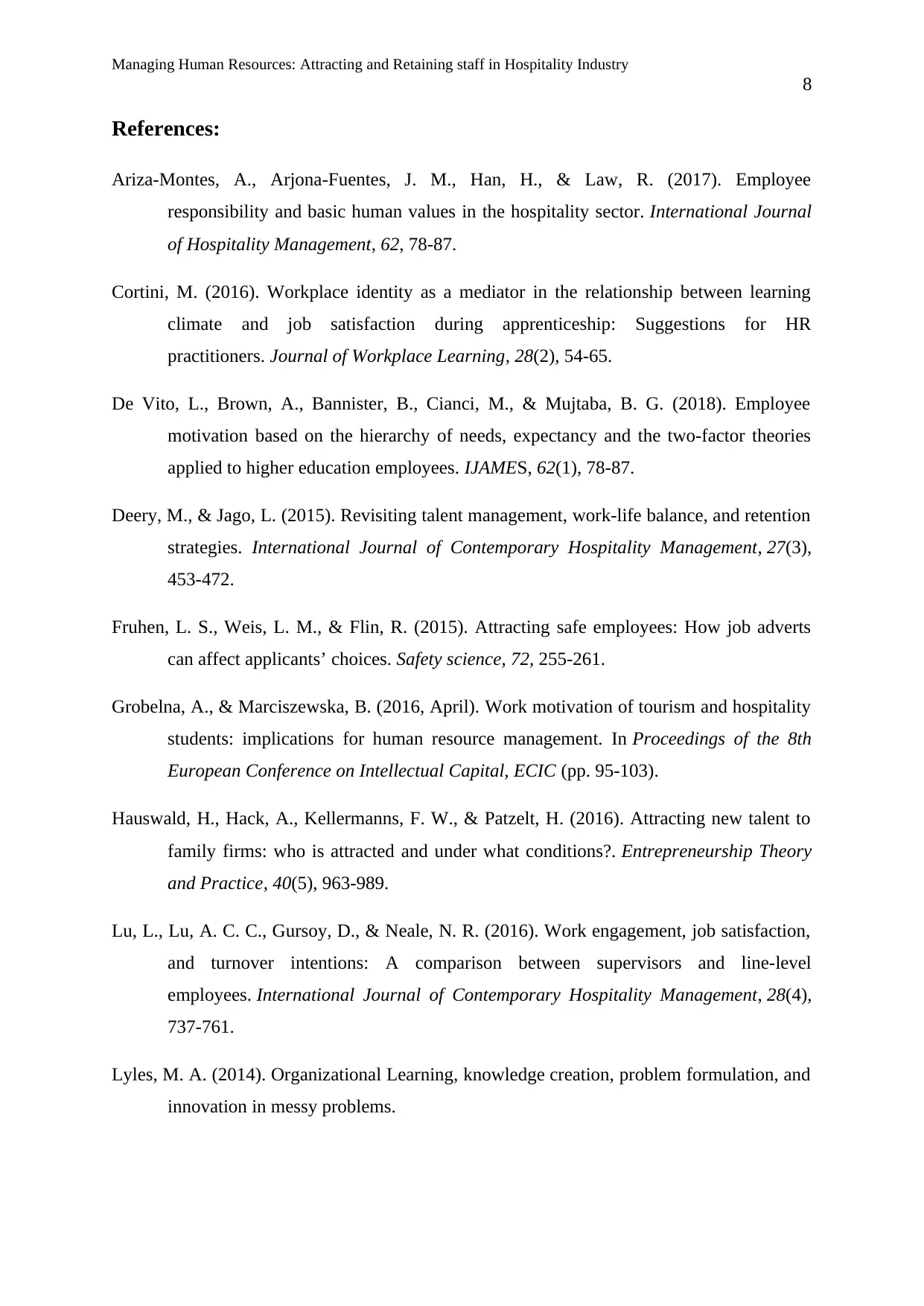
Managing Human Resources: Attracting and Retaining staff in Hospitality Industry
8
References:
Ariza-Montes, A., Arjona-Fuentes, J. M., Han, H., & Law, R. (2017). Employee
responsibility and basic human values in the hospitality sector. International Journal
of Hospitality Management, 62, 78-87.
Cortini, M. (2016). Workplace identity as a mediator in the relationship between learning
climate and job satisfaction during apprenticeship: Suggestions for HR
practitioners. Journal of Workplace Learning, 28(2), 54-65.
De Vito, L., Brown, A., Bannister, B., Cianci, M., & Mujtaba, B. G. (2018). Employee
motivation based on the hierarchy of needs, expectancy and the two-factor theories
applied to higher education employees. IJAMES, 62(1), 78-87.
Deery, M., & Jago, L. (2015). Revisiting talent management, work-life balance, and retention
strategies. International Journal of Contemporary Hospitality Management, 27(3),
453-472.
Fruhen, L. S., Weis, L. M., & Flin, R. (2015). Attracting safe employees: How job adverts
can affect applicants’ choices. Safety science, 72, 255-261.
Grobelna, A., & Marciszewska, B. (2016, April). Work motivation of tourism and hospitality
students: implications for human resource management. In Proceedings of the 8th
European Conference on Intellectual Capital, ECIC (pp. 95-103).
Hauswald, H., Hack, A., Kellermanns, F. W., & Patzelt, H. (2016). Attracting new talent to
family firms: who is attracted and under what conditions?. Entrepreneurship Theory
and Practice, 40(5), 963-989.
Lu, L., Lu, A. C. C., Gursoy, D., & Neale, N. R. (2016). Work engagement, job satisfaction,
and turnover intentions: A comparison between supervisors and line-level
employees. International Journal of Contemporary Hospitality Management, 28(4),
737-761.
Lyles, M. A. (2014). Organizational Learning, knowledge creation, problem formulation, and
innovation in messy problems.
8
References:
Ariza-Montes, A., Arjona-Fuentes, J. M., Han, H., & Law, R. (2017). Employee
responsibility and basic human values in the hospitality sector. International Journal
of Hospitality Management, 62, 78-87.
Cortini, M. (2016). Workplace identity as a mediator in the relationship between learning
climate and job satisfaction during apprenticeship: Suggestions for HR
practitioners. Journal of Workplace Learning, 28(2), 54-65.
De Vito, L., Brown, A., Bannister, B., Cianci, M., & Mujtaba, B. G. (2018). Employee
motivation based on the hierarchy of needs, expectancy and the two-factor theories
applied to higher education employees. IJAMES, 62(1), 78-87.
Deery, M., & Jago, L. (2015). Revisiting talent management, work-life balance, and retention
strategies. International Journal of Contemporary Hospitality Management, 27(3),
453-472.
Fruhen, L. S., Weis, L. M., & Flin, R. (2015). Attracting safe employees: How job adverts
can affect applicants’ choices. Safety science, 72, 255-261.
Grobelna, A., & Marciszewska, B. (2016, April). Work motivation of tourism and hospitality
students: implications for human resource management. In Proceedings of the 8th
European Conference on Intellectual Capital, ECIC (pp. 95-103).
Hauswald, H., Hack, A., Kellermanns, F. W., & Patzelt, H. (2016). Attracting new talent to
family firms: who is attracted and under what conditions?. Entrepreneurship Theory
and Practice, 40(5), 963-989.
Lu, L., Lu, A. C. C., Gursoy, D., & Neale, N. R. (2016). Work engagement, job satisfaction,
and turnover intentions: A comparison between supervisors and line-level
employees. International Journal of Contemporary Hospitality Management, 28(4),
737-761.
Lyles, M. A. (2014). Organizational Learning, knowledge creation, problem formulation, and
innovation in messy problems.
⊘ This is a preview!⊘
Do you want full access?
Subscribe today to unlock all pages.

Trusted by 1+ million students worldwide
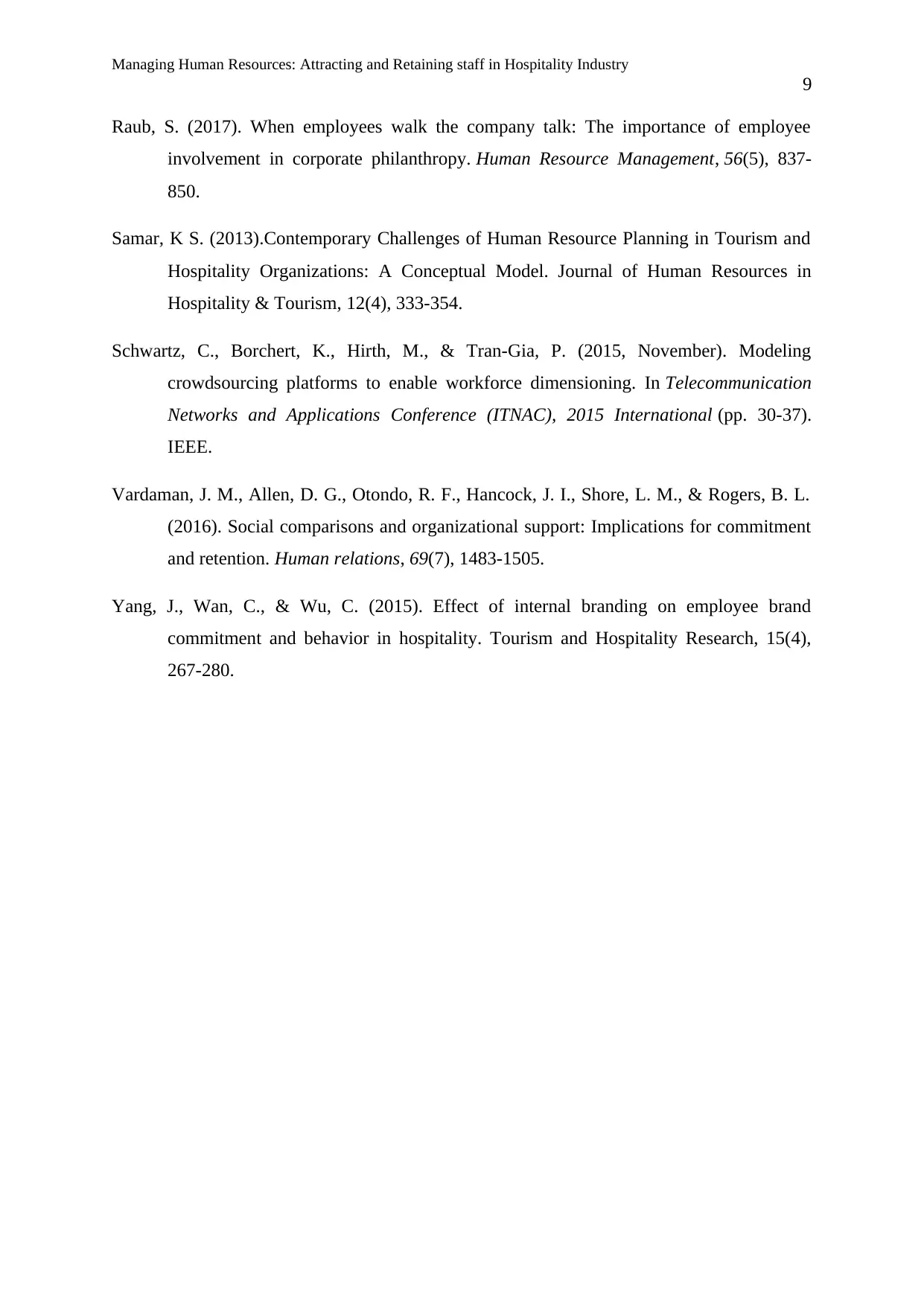
Managing Human Resources: Attracting and Retaining staff in Hospitality Industry
9
Raub, S. (2017). When employees walk the company talk: The importance of employee
involvement in corporate philanthropy. Human Resource Management, 56(5), 837-
850.
Samar, K S. (2013).Contemporary Challenges of Human Resource Planning in Tourism and
Hospitality Organizations: A Conceptual Model. Journal of Human Resources in
Hospitality & Tourism, 12(4), 333-354.
Schwartz, C., Borchert, K., Hirth, M., & Tran-Gia, P. (2015, November). Modeling
crowdsourcing platforms to enable workforce dimensioning. In Telecommunication
Networks and Applications Conference (ITNAC), 2015 International (pp. 30-37).
IEEE.
Vardaman, J. M., Allen, D. G., Otondo, R. F., Hancock, J. I., Shore, L. M., & Rogers, B. L.
(2016). Social comparisons and organizational support: Implications for commitment
and retention. Human relations, 69(7), 1483-1505.
Yang, J., Wan, C., & Wu, C. (2015). Effect of internal branding on employee brand
commitment and behavior in hospitality. Tourism and Hospitality Research, 15(4),
267-280.
9
Raub, S. (2017). When employees walk the company talk: The importance of employee
involvement in corporate philanthropy. Human Resource Management, 56(5), 837-
850.
Samar, K S. (2013).Contemporary Challenges of Human Resource Planning in Tourism and
Hospitality Organizations: A Conceptual Model. Journal of Human Resources in
Hospitality & Tourism, 12(4), 333-354.
Schwartz, C., Borchert, K., Hirth, M., & Tran-Gia, P. (2015, November). Modeling
crowdsourcing platforms to enable workforce dimensioning. In Telecommunication
Networks and Applications Conference (ITNAC), 2015 International (pp. 30-37).
IEEE.
Vardaman, J. M., Allen, D. G., Otondo, R. F., Hancock, J. I., Shore, L. M., & Rogers, B. L.
(2016). Social comparisons and organizational support: Implications for commitment
and retention. Human relations, 69(7), 1483-1505.
Yang, J., Wan, C., & Wu, C. (2015). Effect of internal branding on employee brand
commitment and behavior in hospitality. Tourism and Hospitality Research, 15(4),
267-280.
1 out of 10
Related Documents
Your All-in-One AI-Powered Toolkit for Academic Success.
+13062052269
info@desklib.com
Available 24*7 on WhatsApp / Email
![[object Object]](/_next/static/media/star-bottom.7253800d.svg)
Unlock your academic potential
Copyright © 2020–2025 A2Z Services. All Rights Reserved. Developed and managed by ZUCOL.





